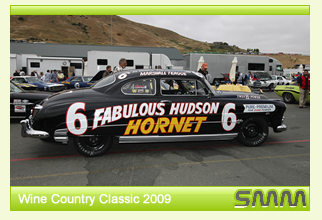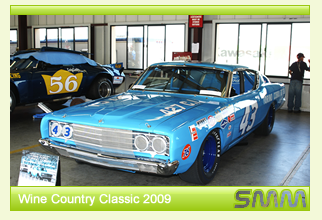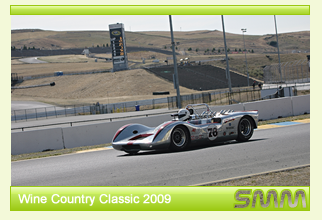There was a time when a racer’s reputation and fame were based solely upon the number of lengths between him and his nearest competitor once the checkered flag was thrown. More times than not, competing cars were driven to the track, raced and then driven home. The prize? A trophy, a kiss from a pretty girl and if you were lucky, a cash payout that might cover a small percentage of the expenses most couldn’t afford in the first place. After all, bragging rights were what really mattered to most and they went a long way, or at least they lasted until the next race was underway.
Life was simpler then and the cars were. too. Early factory innovators like Auto Union, Talbot-Lago and Bugatti, were joined by the likes of Ferrari, Porsche, Maserati and McLaren. These legends in the making merely displayed a number on the side, electrical tape over their headlights, the exhaust was uncorked , and away they went with nothing more than marginal brakes, a roll bar that seemed more like a decoration and a DOHC engine inching up to and beyond its redline. Most importantly, it took tight-fisted determination and love of the sport by the drivers to prove their mettle to the throngs of spectators who were there to quench their need for speed. In some ways, organized auto racing in its infancy was considered the sport of gentlemen. Races had a picnic atmosphere about them and fans could mingle with their favorite drivers inbetween rounds while the car was being serviced by mechanics who could dial in multiple carburetion setups by just listening to the sound of an engine. , and away they went with nothing more than marginal brakes, a roll bar that seemed more like a decoration and a DOHC engine inching up to and beyond its redline. Most importantly, it took tight-fisted determination and love of the sport by the drivers to prove their mettle to the throngs of spectators who were there to quench their need for speed. In some ways, organized auto racing in its infancy was considered the sport of gentlemen. Races had a picnic atmosphere about them and fans could mingle with their favorite drivers inbetween rounds while the car was being serviced by mechanics who could dial in multiple carburetion setups by just listening to the sound of an engine.
It was inevitable that things would change once racing became big business. As the years went by, the fences went up, the cars (and the drivers) were plastered with product logos and the best seat in the house wasn’t on the grassy knoll under the elm tree any longer. A few complained but before long, the “good old days” were forgotten, a distant memory that with the passage of time became a quaint relic of the past.
 It has often been said that “you can never go home again” but there have been many who have been proving this old adage wrong for the past 23 years at a racing facility just north of San Francisco where a special gathering takes place, a gathering where the memories, the style and the thrill of early automotive competition takes center stage once again amidst the backdrop of the gentle rolling hills of Northern California. It was easy to imagine yourself standing along the Mulsanne Straight of LeMans, the Chicane du Port at Monaco, the Gerlach turn at Zandvoort or the Wedgewood at Watkins Glen. All these things became real once again when nearly 350 racing machines dating back to 1914 resumed their rightful place of prominence during the Wine Country Classic Vintage Car Races, held May 30-31, 2009, at Infineon Raceway/Sonoma California (http://www.infineonraceway.com). It has often been said that “you can never go home again” but there have been many who have been proving this old adage wrong for the past 23 years at a racing facility just north of San Francisco where a special gathering takes place, a gathering where the memories, the style and the thrill of early automotive competition takes center stage once again amidst the backdrop of the gentle rolling hills of Northern California. It was easy to imagine yourself standing along the Mulsanne Straight of LeMans, the Chicane du Port at Monaco, the Gerlach turn at Zandvoort or the Wedgewood at Watkins Glen. All these things became real once again when nearly 350 racing machines dating back to 1914 resumed their rightful place of prominence during the Wine Country Classic Vintage Car Races, held May 30-31, 2009, at Infineon Raceway/Sonoma California (http://www.infineonraceway.com).
Walking through the paddock was a CliffsNotes education in automotive history -- the 1939 Auto Union D Type V12, the 1948 Talbot-Lago T 26C, the McLarens, the Morgans, the Ferraris and the Grand National  stockers. The list went on and on. It was almost too much to take it all in when these ancient thoroughbreds came alive and headed out to re-establish and re-affirm the reason why they were created in the first place. stockers. The list went on and on. It was almost too much to take it all in when these ancient thoroughbreds came alive and headed out to re-establish and re-affirm the reason why they were created in the first place.
This SCCA (Sports Car Club of America) sanctioned event featured 100 years of Morgan, a corral for Austin Minis and one for Ford GT40s, Mustangs and Shelby AC Cobras. The variety, the color and the pageantry on exhibit that weekend will be remembered and celebrated because of those few individuals who have taken it upon themselves to preserve a piece of racing history, not for a trophy and not for glory or fame. Imagine that.
Wine Country Classic 2009 Gallery
|
Group I
Pre-War Racing Cars and Sports Cars to 1952
1932 Alfa Romeo
Tom Price--Larkspur, Calif.
Group II
1948-55 Sports Racing and Production Cars
1952 Schaghticoke Manning Special
Robert Manson—Redwood City, Calif.
Group III
1956-62 Production Cars
1959 Morgan
Jeff Abramson—Danville, Calif.
Group IV
1955-61 Sports Racing Cars
1958 Scarab
Rob Walton—Paradise Valley, Ariz.
Group V
1958-63 Formula Jr./F-1 & F-2 Cars
1963 Lotus
Nick Colyvas—San Francisco, Calif.
|
Group VI
1963-66 Production Sports Cars
1964 Lotus
John Delane—Redondo Beach, Calif.
Group VII
1961-65 Sports Racing Cars
1964 Elva
Tom Nuxoll—Medina, Wash.
Group VIII
1966-72 Historic Trans-Am Cars
1970 Javelin
Bruce Canepa—Scotts Valley, Calif.
Group IX
1961-72 Historic Can-Am Cars and FIA to 1978
1976 Lola T-286
Bert Skidmore—Sparks, Nev.
Group X
1971-81 Historic IMSA GT
1981-88 IMSA GTO Cars
1976 Porsche
Ranson Webster—Reno, Nev. |





